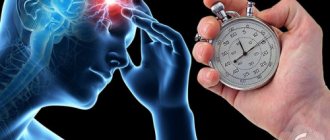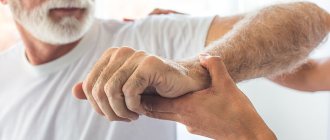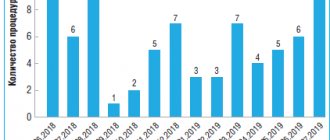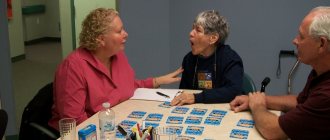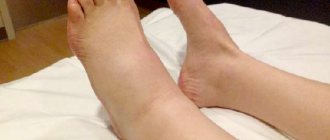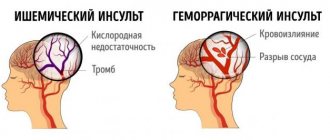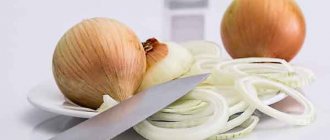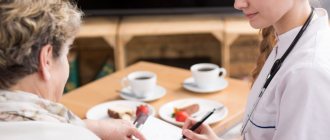March 15, 2021
When the acute stage after a stroke ends, the patient is discharged from the hospital, then a new period begins - the person’s recovery after a stroke at home.
In this article we tell you how to properly care for victims, restore their movement and cognitive functions, and provide psychological support so that rehabilitation after a stroke at home is systematic and gives the desired effect.
What to do immediately after a stroke at home?
Proper recovery after a stroke at home with the support of relatives and under the supervision of doctors brings good results. It is important to start rehabilitation immediately and not to miss the “rehabilitation window” - this is the year after the stroke, when treatment gives the maximum result.
Recovery after strokes is divided into several periods; the time may shift depending on the patient’s condition.
| The most acute period | Acute period | Early recovery period | Late recovery period | Period of residual effects |
| First 5 days | 3-4 weeks | Up to 6 months | 6-12 months | After 1 year |
Find out how to get comprehensive rehabilitation at home in St. Petersburg with an effectiveness of 95% of the intended result
To know
Rules for caring for victims after a stroke
When a loved one has a stroke, rehabilitation at home is a high responsibility and a lot of physical activity for his relatives. It is important to prepare and create a comfortable atmosphere for the person. And then keep the order in the room and its cleanliness, prepare healthy food. Proper living will improve the mood and condition of the patient, thanks to this the person’s recovery after a stroke at home will progress.
Preparing the room and bed
After a stroke, rehabilitation at home should be comfortable for the patient. You need a spacious and bright room where there are large windows and no unnecessary noise is heard. All the furniture in the room is stable; in the future it will be a support when walking.
It is important to place a functional bed with an anti-bedsore mattress with the head of the bed against the wall so that the patient can be approached from all sides. Adjust the height of the bed, elevate the head or legs, and install protective bars to prevent the patient from falling.
The bed should consist of a pillow that supports the head, a light blanket, and a sheet without folds. Next to the bed you need a bedside table with water and necessary things for a person, and below there is a toilet chair.
While lying on the bed, let your healthy arm and leg be next to the wall so that you can see what is happening in the room through the sore side. Seeing a changing situation, a person’s affected areas of the brain are activated, accelerating recovery.
There are several tips on how to improve a person’s life after a stroke:
- arrange things at home so that the patient does not bend over or rise “on his tiptoes” behind them; long handles on brushes, brooms or mops will help avoid unnecessary bending;
- Place a damp towel or non-slip board on the table to prevent the dishes from slipping;
- support the patient’s forearm at a certain height, so his hand will not get tired quickly. This can be done using a height-adjustable table, a bed tray with legs, or a special forearm support that is attached to the armrests of the chair;
- Place a foam attachment on the handle of a brush, razor, spoon, or comb or buy a special “smart” item.
Body hygiene and the fight against bedsores
Bedsores harm the patient's recovery. They appear when the hard surface of a bed, chair, orthopedic devices, a lump from a sheet or pajamas presses on the person’s body. Bedsores can also form when moving, turning or improperly changing bed linen.
Most often, redness, blisters, like a burn, and small abrasions appear above the protrusions of the bones in the area of the back of the head, shoulder blades and sacrum. An anti-bedsore mattress, body hygiene and proper care will help to avoid the appearance of bedsores. You need to change your position in bed as often as possible, turning every two hours. It is necessary to keep the skin clean and ensure that it is not too wet or dry. You can treat it 1-2 times daily with camphor alcohol.
When caring for someone at home after a stroke, it is important to examine the patient every day. It is necessary to ensure that there are no folds or food crumbs on the sheet. When changing linen, do not pull the sheet out from under the patient, but pull it out carefully. You should not put oilcloth under your body; it is better to use diapers or an absorbent disposable sheet.
If bedsores do appear, use hydrogen peroxide to treat wounds and special ointments.
Nutrition
Food for the patient should be tasty and warm. It is necessary to take 4-5 doses a day, with dinner no later than 2 hours before bedtime. All food is prepared without salt, but sometimes the doctor allows you to add up to 5 g, he will definitely inform you about this at the appointment.
For the patient, food is prepared either boiled or baked. It is allowed to eat bread, soups, cereals, dairy products, fruits, eggs, vegetables and herbs, pasta, and for sweets - honey.
There are certain recommendations about what foods a patient can eat after a stroke:
| Can | Limit | Exclude |
| no oil | vegetable oil | lard, butter, margarine |
| red river fish | fatty fish: sturgeon, halibut | caviar |
| skinless chicken | all types of meat without fat | sausages, frankfurters, meat with fat |
| low-fat milk, kefir, cottage cheese | whole milk, cheese | fat milk, sour cream, cream |
| bananas, cucumbers, tomatoes, legumes | potato | preserves, jams |
| oatmeal, rice, buckwheat porridge, black bread | white bread, pasta | baking, muffin |
| green tea, mineral water, natural juices | sugar | chocolate, candy, pastille |
Sometimes patients after a stroke have problems swallowing. Such a person should be given soft food, not liquids, since liquids immediately enter the trachea and cause coughing. If swallowing is impaired, the patient should not be left alone; it is important to ensure that he concentrates on eating and tilts his head when chewing. A speech therapist-aphasiologist helps with swallowing problems.
Sample menu for 1 day:
Breakfast : 2 egg white omelette or oatmeal, tea or coffee with milk.
Second breakfast : boiled beef stroganoff, cottage cheese, apple or rose hip decoction.
Lunch : soup, boiled meat with vegetables, apple compote.
Dinner : boiled fish with mashed potatoes, pilaf with fruit, tea with milk. At night : a glass of curdled milk or prunes
Effective pharmacotherapy in the recovery period after ischemic stroke
The article discusses the principles of therapy for patients in the recovery period after an ischemic stroke. The results of numerous clinical studies have demonstrated the effectiveness, safety and good tolerability of Cerepro (choline alfoscerate) in patients after cerebrovascular accident. Such therapy is pathogenetically justified, since it stimulates the processes of neuroplasticity. The importance of diagnosis and further correction of post-stroke depressive disorders for the prognosis and functional recovery of patients after a stroke is shown. Adepress (paroxetine) is characterized by safety, good tolerability, high efficiency and low incidence of side effects in long-term treatment of post-stroke depression; its use is pathogenetically justified in the treatment of this category of patients.
Drawing. Main mechanisms of action of Cerepro (choline alfoscerate)
Introduction
Cerebrovascular diseases represent an urgent medical and social problem of modern medicine due to their widespread prevalence, high risk of mortality and profound disability in people of working age, as well as the significant economic damage that these diseases cause to the economies of most developed countries of the world [1–3]. In Russia alone, cerebrovascular diseases are observed in 5.4 million people [4] and are in second place after cardiovascular diseases among all causes of death in the population [5].
Ischemic stroke, which accounts for about 80% of all types of acute cerebrovascular accidents, is one of the leading causes of mortality, disability and severe maladaptation of patients. In this case, approximately 2/3 [6] or 75% [7] of patients exhibit residual effects of cerebral circulatory disorders of varying severity. According to the National Stroke Registry, about 450 thousand cases of the disease are registered annually in Russia, the mortality rate reaches 35% [5], and only about 20% of surviving patients can return to their previous work [8].
The problem of ischemic stroke is currently receiving great attention. Thus, international and domestic recommendations have been developed for the prevention of stroke, treatment and rehabilitation of patients who have suffered a stroke. In neurological hospitals, high-tech methods of restorative treatment have been introduced, which significantly reduce post-stroke mortality and improve functional outcomes, and the National Stroke Association has been organized [2, 5, 8]. At the same time, in recent years there has been a steady increase in the number of patients with both acute cerebrovascular accidents and chronic cerebrovascular pathology, and increasingly these are young and middle-aged people. In this regard, the priority task of modern angioneurology in particular and the entire healthcare system in general is considered to be the search for optimal and highly effective methods of treatment and neurorehabilitation of patients with cerebrovascular diseases. These methods should be aimed not only at restoring impaired functions, social contacts and professional skills, but also at preventing the progression of neurological and mental disorders [2, 8].
The basic principles of complex treatment of ischemic stroke include basic (correction of basic vital functions), reperfusion (use of anticoagulants, antiplatelet agents and tissue plasminogen activators) and neuroprotective (prevention, interruption and reduction of pathological effects on the brain) therapy, neurorehabilitation and secondary prevention [9] .
In the pathogenesis of vascular lesions of the brain, the leading role is given to the processes of ischemia, excitotoxicity, apoptosis and multidirectional mediator imbalance: excessive activation of the glutamatergic system, on the one hand, and insufficient activity of the cholinergic and GABAergic systems, on the other [8, 10]. Taking into account these features of pathogenesis, pharmacological agents that affect neurotransmitter systems are actively used in the treatment of patients with cerebrovascular diseases. It should be noted that the cholinergic system, widely represented in various parts of the central nervous system (CNS), evolutionarily protects brain neurons from excessive catecholamine effects, supporting the functioning of neuronal populations, closely interacts with the dopamine, GABA and glutamatergic systems, ensuring emotional behavior, memory and volitional acts [5, 11]. In this regard, the feasibility of influencing the cholinergic apparatus of the central nervous system in the treatment of patients with cerebrovascular diseases is beyond doubt.
The leading role in maintaining the functioning of neuronal structures and systems in normal conditions and in cases of damage to the central nervous system is the phenomenon of neuroplasticity - the ability of cells of the nervous system to change both structural and functional organization under the influence of external and internal factors [1, 11]. This fundamental concept also implies anatomical and functional quantitative and qualitative changes at the level of neuronal connections and glial elements, the development of new sensorimotor pathways and integrations into the central nervous system during the recovery process [12, 13]. One of the pathogenetic mechanisms that implement or inhibit the processes of neuroplasticity are functional changes in neurotransmitter systems and subsequent multidirectional changes in the activity of neuronal systems. Thus, in the recovery period after damage to the central nervous system, the intensity of neuroplastic processes increases with the activation of glutamatergic NMDA receptors, noradrenergic, dopaminergic and serotonergic receptors and, on the contrary, decreases or slows down with stimulation of inhibitory GABAA receptors [14]. These pathophysiological features explain the lack of expected improvement in impaired functions in stroke patients after excessively active and early rehabilitation [14].
Thus, the therapeutic strategy in general and the choice of drug in particular when conducting rehabilitation treatment in post-stroke patients are determined by the beneficial effect on the processes of neuroplasticity in cerebral neuronal systems [1]. A wide range of drugs have a stimulating or inhibitory effect on plasticity processes in the brain immediately after a circulatory disorder and subsequently throughout the entire recovery period. The effectiveness of the drug is determined both by the prevalence and localization of the lesion, and the timing of the therapy, its interaction with other therapeutic measures [12].
Neuroprotection in the post-stroke period
In modern medical practice, the only criterion for justifying the prescription of certain drugs is the data from clinical studies performed in accordance with the principles of Good Clinical Practice [15]. In particular, rational treatment, the effectiveness of which has been confirmed in such studies, includes thrombolysis and antiplatelet therapy [16]. The most promising direction, which has been actively developed in recent years by domestic researchers, can be called neurocytoprotection. This is a system of measures that increase the body’s resistance to extreme effects and have a positive effect on the functional activity of brain cells, which has not only therapeutic but also preventive significance in patients with cerebrovascular pathology [16].
Neuroprotection is a strategically important and pathogenetic direction in the treatment of patients with cerebrovascular accidents from the first hours of a stroke and throughout the entire recovery period [1]. Considerable experience has been accumulated in the use of drugs of various pharmacological groups with potential cytoprotective properties affecting the dopaminergic, glutamatergic, GABAergic and cholinergic systems. Among the anticholinergic drugs, the most pharmacologically effective and in demand in the treatment of cerebrovascular diseases are considered to be drugs whose point of application is localized at the presynaptic level or the level of cholinesterases [15]. The drug Cerepro (choline alfoscerate), which has proven itself well in the neuropharmacological market, meets these requirements.
The drug Cerepro is a centrally acting cholinomimetic, contains 40.5% metabolically protected choline; in the body, under the action of enzymes, it is broken down into choline and glycerophosphate (figure). Choline is involved in the biosynthesis of acetylcholine in the presynaptic membranes of cholinergic neurons, the bulk of which are concentrated in the cerebral cortex, cerebellum, basal ganglia, thalamus and hippocampus. Glycerophosphate is a precursor to phospholipids (phosphatidylcholine) of the neuronal membrane and myelin. Thus, choline alfoscerate (Cerepro), participating in the anabolic processes of phospholipid and glycerolipid synthesis, has a positive effect on the functional activity of membrane structures of cells, providing their matrix functions by increasing the mass of organelles (ribosomes and mitochondria) and improving membrane plasticity (see figure ) [16, 17].
It should be noted that a sharp decrease in the metabolism of phospholipids and, accordingly, their pool with subsequent damage to neuronal membranes is observed in many pathological conditions of the central nervous system and plays a key role in the formation of various pathophysiological reactions. In particular, in the occurrence of an excitotoxic cascade and the triggering of mechanisms of programmed cell death (apoptosis), the development of ischemia, hypoxia and neurodegeneration, as well as vasogenic and traumatic cerebral edema [18, 19]. In this regard, the use of drugs capable of restoring the cerebral cell membrane and its components is one of the most promising areas of cytoprotection in ischemic stroke. An important advantage of the drug Cerepro (choline alfoscerate) compared to other presynaptic anticholinergic drugs is the direct preservation, and possibly increase and deposition of the endogenous pool of acetylcholine, myelin and phospholipids [17]. This property makes it advisable to use Cerepro in patients after cerebral stroke.
The clinical efficacy and tolerability of choline alfoscerate in the treatment of patients with cerebrovascular diseases are being actively studied by domestic researchers [5, 15, 16, 17, 20]. It has been shown that choline alfoscerate increases the resistance of neurons to ischemic effects, improves blood flow and enhances metabolic and reparative processes in the ischemic focus, activates the structures of the reticular formation, having a positive effect on cognitive and behavioral reactions, and normalizes the balance of mediators in the central nervous system [5, 17].
A multicenter, double-blind, randomized, placebo-controlled study demonstrated significant efficacy and safety of the use of Cerepro in 103 patients (mean age 61.17 ± 8.12 years) in the acute period (in the first 48 hours) of ischemic stroke that first occurred in the carotid system. The severity of the neurological deficit ranged from 10 to 20 points (inclusive) on the National Institutes of Health Stroke Scale (NIHSS). The drug Cerepro was prescribed according to the following scheme: the first ten days intravenously at a dose of 2000 mg per day, followed by intramuscular administration at a dose of 1000 mg per day for ten days. Patients receiving Cerepro in combination with basic therapy showed a more significant regression of neurological symptoms (hemianopia, paresis, ataxia and aphasia) and greater positive dynamics of functional outcome according to the Barthel index compared to the group receiving placebo along with basic treatment [15].
Another study involving 60 patients in the early recovery period after an ischemic stroke in the basin of different cerebral arteries demonstrated a good effect of eight-week therapy with Cerepro in more than half of the patients (65%), very good in 11.7% and satisfactory in 23 .3% of patients. The effectiveness and safety of treatment was assessed using the Mini Mental State Examination (MMSE), the Barthel Index, and the Clinical Global Impression (CGI) scale.
Treatment with Cerepro decreased the severity of paresis, coordination and asthenic disorders, and improved cognitive functions, mood, mobility of patients and their ability to self-care [20]. The drug was well tolerated.
Of interest are the data from a domestic study of the effectiveness, tolerability and safety of the drug Cerepro in patients who suffered an ischemic stroke four to six months ago (n = 60), and in patients with chronic cerebral ischemia (n = 30) [5]. Cerepro was taken intravenously in the first ten days at a dose of 1000 mg per day, then for six weeks orally at a dose of 1200 mg per day. All patients also received basic drug therapy according to the standards of medical care. A reliable nootropic effect of the drug has been established in the form of improvement of cognitive functions (attention, memorization and reproduction of information), a decrease in the severity of asthenic syndrome and an improvement in mood have been shown [5]. The results of treatment were assessed before and after the end of intravenous administration of the drug, as well as after completion of oral administration of Cerepro using the well-known clinical scales MMSE, Hamilton, CGI and methods of rapid assessment of well-being, activity and mood. It should be noted that the treatment was more effective in the group of patients in the early post-stroke recovery period due to the reduction of cognitive and coordination impairments in the absence of serious adverse events that required additional measures [5].
Thus, the safety, effectiveness and good tolerability of the drug Cerepro (choline alfoscerate) in patients with acute and chronic cerebral circulatory failure have been confirmed in several domestic studies [5, 15, 16, 20]. At the same time, a reliable effect of improving impaired functions was shown not only in patients in the acute and early recovery periods after an ischemic stroke, but also in patients with chronic cerebral ischemia.
Despite the existing opinion that the most intensive restoration of impaired functions occurs in the first three to six months after a cerebrovascular accident, in a significant proportion of patients, positive dynamics of recovery processes are observed over a longer period (for two or more years) [12, 21, 22] . This occurs both as a result of spontaneous recovery and against the background of rehabilitation measures carried out at this time [23], which makes it possible to carry out neurorehabilitation of post-stroke patients at a later date [23, 24]. At the same time, the processes of neuroplasticity characteristic of early development and the subacute phase after a stroke are limited and slow down over time [1]. Therefore, it is important to look for ways to expand the so-called therapeutic window and/or lengthen it in order to optimize recovery after ischemic stroke. Various methods of physical and neuropsychological rehabilitation, proper care and an interdisciplinary management principle have a significant impact on the degree of restoration of impaired functions in patients after a stroke. At the same time, timely and adequate drug treatment plays an important role in the comprehensive rehabilitation of patients after a stroke [2].
It can be concluded that choline alfoscerate (Cerepro) is an effective neuroprotector, the use of which is pathogenetically justified not only in patients who have suffered acute cerebrovascular accident throughout the entire recovery period, but also in patients with chronic cerebral ischemia. The drug can be recommended for use in complex therapy of patients with cerebrovascular diseases at all stages of inpatient and outpatient rehabilitation.
Treatment methods for post-stroke depression
Neurorehabilitation of patients after cerebrovascular accident is one of the most important medical areas of modern healthcare. At the same time, factors that negatively affect the rehabilitation potential and further restoration of impaired functions in patients with stroke include changes in the psycho-emotional sphere and the sphere of higher mental functions: depression and dementia after a stroke [25].
Post-stroke depression was first described in 1980 as one of the possible complications of stroke [26]. Until today, depressive disorders in patients after cerebrovascular accident are of significant interest to researchers due to the high incidence of both the stroke itself and post-stroke depression, which is observed in approximately every third patient [27].
Depressive disorders make it difficult to assess the neurological status of patients after a stroke, significantly reduce the effectiveness of rehabilitation measures and significantly worsen the quality of life and social adaptation [27, 28]. With severe depression after a stroke, impaired functions are restored more slowly, patients experience more complications, higher mortality rates, and patients are less committed to preventing recurrent vascular episodes [28]. That is why it is important to diagnose and promptly begin appropriate treatment for mental disorders.
The pathophysiological mechanisms of the development of depression after cerebrovascular accident are heterogeneous and not fully understood. At the same time, it has been shown that post-stroke depression is based on an imbalance in the functional activity of neurotransmitter systems and a deficiency of biogenic amines [27]. Some studies have demonstrated a significant correlation between the development of severe depression and a decrease in serotonin levels. On the contrary, correction of the content of this neurotransmitter in patients after a stroke led to regression of the severity of their emotional disorders [27, 28]. Thus, the use of drugs that normalize serotonin metabolism in patients after a stroke is pathogenetically justified.
In recent years, selective serotonin reuptake inhibitors (SSRIs) have been increasingly used in clinical practice because they have a broad spectrum of action and a high safety and tolerability profile. This makes their use preferable for long-term treatment, the presence of somatic pathology and elderly patients. One of the drugs in the SSRI group, paroxetine (Adepress), is characterized by safety, good tolerability, high efficiency and low incidence of adverse events during long-term treatment, which is associated with the lack of interaction with alpha-1-adrenergic, H1-histamine and muscarinic receptors [29]. It should be noted that the convenient regimen of taking the drug (once a day) and the pronounced thymoanaleptic effect of Adepress contribute to the adherence of patients after a stroke to the prescribed therapy. This is important because the duration of treatment for post-stroke depression is at least six months. The beneficial effect of SSRIs on the functional activity of neuronal systems of the brain is probably based on their ability to stimulate the production of brain neurotrophic factors and ultimately enhance the processes of neuronal plasticity [30].
At the same time, the insufficient clinical effect of the use of pathogenetically justified drugs of various pharmacological groups or its absence in patients after a stroke may be due to a number of factors: late prescription of the drug, inadequate doses and/or duration of its use and the lack of effective basic and reperfusion therapy [1]. Of course, one of the main criteria for choosing a drug when conducting rehabilitation treatment in post-stroke patients is considered to have a beneficial effect on the processes of neuroplasticity of brain tissue [15]. Today, an angioneurologist must have a good knowledge of not only the indications and contraindications for the prescription of various drugs, but also the pharmacokinetics, pharmacodynamics and features of the interaction of different drugs. Taking into account the high prevalence of depression after a stroke and its importance for prognosis and functional recovery, it is recommended to screen for the presence of psychoemotional disorders in all patients who have suffered an acute cerebrovascular accident; if necessary, they should be prescribed antidepressant therapy.
Conclusion
Drug support of the recovery process after cerebrovascular accident is an important area of neurorehabilitation. At the same time, despite the existence of a large arsenal of rehabilitation technologies, a whole range of different techniques and medications, the percentage of disability and social maladaptation of patients after ischemic stroke remains quite high [13]. This necessitates further comprehensive study of the mechanisms of compensatory processes in the central nervous system after a stroke in order to create new drugs and develop new methods to improve the effectiveness of rehabilitation measures and reduce the prevalence and severity of post-stroke disability.
Motor rehabilitation
Restoration of movements should be gradual. This path is similar to a high ladder: first you need to learn to roll over, then control your head, then sit, stand, gradually walk and increase speed.
The most important thing is not to step over these steps in order to quickly reach the pinnacle of recovery. Each missed step is harmful, so it is important to learn how to move correctly and strengthen these skills with exercises. Below we have collected some tips on what to do at home after a stroke - when and how to roll over in bed, sit down and stand up.
How to lie down and turn over
You cannot always be in a lying position, as this will strain your back, arms and legs, and this will cause pain in the body.
To reduce pain and fatigue, use pillows. If your hand hurts, place it on a soft surface with your palm facing up. The same can be done with a sore leg. Place your limb on a pillow and bend your knee. The hip will rest on the pillow, and the sore leg will not roll off. It is important that raising the head of the bed is only possible during rehabilitation of ischemic stroke at home.
Learning to turn over in bed is the first step to recovery. An assistant is needed to turn to the paralyzed side. A caregiver or relative stands on the person's affected side and helps him turn by holding his healthy shoulder, knee or hip.
When and how to sit down and stand up
If the patient can sit up, change the position every day. It is necessary to move closer to the head of the bed and sit up straight, and distribute the weight evenly on both buttocks.
After the doctor's permission, you should learn to change seats. In the future, this skill will help you use the bathroom and toilet and be more independent. When transplanting for the first time, you need to monitor every movement in order to accustom your body to the correct technique. It is necessary to place your feet shoulder-width apart in one line, move your legs to the legs of a chair or armchair. Lean forward, resting your hands on the armrest, then straighten up and, maintaining your balance, gradually stand up, straightening your legs.
After a stroke, special training will help you recover at home. The number and time of their implementation are prescribed by the doctor, but you can use simple exercises yourself.
Therapeutic exercises to restore movement:
Each exercise should be done 4-6 times under the supervision of relatives or a caregiver.
Lying on your back, place your arms along your body, calmly inhale and exhale:
- Flex your feet vigorously, tensing your legs;
- make wide circular rotations with your feet in both directions;
- lift your legs up one by one;
- alternately bend your legs at the knee, clasping them with your hands;
- straighten your limbs.
Sitting on a chair:
- simultaneously and alternately rise onto your toes, straining your calf muscles;
- straighten your legs forward with tension in your hips;
- sit on the tip of the chair, holding onto the seat, move your straight leg to the side one at a time.
While standing, walk in place:
- raise your knee higher;
- lower your arms and rotate your straight arm in and out;
- put your hands on your belt, slightly bend your torso to the side;
- step forward, spreading your arms to the sides.
How to improve coordination of movements
After a stroke, areas of the brain that are responsible for coordinating movements are often damaged. As a result, the patient may lose his balance when standing, sway when walking, and move his arms randomly. To improve coordination, you can do daily training.
Exercises to improve coordination of movements:
- throw an object at a target. Gradually you need to increase the mass of the object, move the target away and reduce its area;
- swing movements in large joints, turns and tilts of the body, according to the patient’s condition;
- eye movements in different directions with a motionless head, also depending on the patient’s condition.
Self-massage
A patient after a stroke needs massage. It calms the body and reduces pain. Only a specialist can use the correct technique, but sometimes self-massage can be done to improve the patient’s condition. It consists of four actions: stroking, rubbing, kneading and vibration.
When stroking, the hands move evenly over the massaged area and glide easily over the skin. You need to move from the fingertips to the armpit, on the back - from the lower back upward, in the lumbar region - from the spine to the sides, the joints are massaged in a circle in any direction.
Rubbing is more effective than stroking. It increases blood circulation and improves tissue nutrition. Rubbing is performed using the same technique as stroking, only a little stronger.
Kneading is a complex technique and should be done carefully. Performed with the palm, fist, several fingers, thumb.
Vibrating massagers are used for vibration. Shock movements with vibration increase muscle tone.
There are some tips that will help you do self-massage correctly and avoid mistakes:
- massage movements should not cause pain. After correct movements, there are no bruises and the skin is not damaged;
- the duration of self-massage is from 3 to 25 minutes, depending on the patient’s condition;
- The patient’s position should be comfortable, all muscles of the massaged area should be relaxed;
- You cannot do self-massage during feverish conditions, during inflammatory processes, in areas where there is eczema, lichen, boils, fungus, thrombophlebitis, varicose veins;
- you can use products for better glide. But it is better to perform self-massage simply with clean, warm hands.
Differentiated treatment of ischemic stroke
The specific (differentiated) treatment of ischemic stroke is based on reperfusion therapy aimed at restoring the lumen of the vascular bed. Among the methods of treating ischemic stroke, thrombolytic therapy is a method whose effectiveness has been proven by the results of large multicenter studies. The first study, conducted by the National Institute of Nerve Diseases and Stroke in 1995, showed that intravenous rt-PA administered within 3 hours of the onset of ischemic stroke significantly improved outcome. Also in 1995, the results of the European Study of Acute Ischemic Stroke (ECASS-1) were published, which studied the effectiveness of rt-PA prescribed within 6 hours of the onset of stroke at a dose of 1.1 mg/kg. Along with clinical improvement, some patients had a high risk of intracerebral hemorrhage. Three years later, results emerged from the ECASS-2 study, which was performed with rt-PA at a dose of 0.9 mg/kg within a 6-hour “therapeutic window.” Good recovery was observed in 54.3% treated with rt-PA, compared with 46% treated with placebo. Another large study assessed the effectiveness of rt-PA when administered within 3 to 5 hours of the onset of stroke symptoms. The results of this study, like ECASS-2, showed that the incidence of intracerebral hemorrhage was slightly higher when rt-PA was administered within 6 hours than within 3 hours.
A study of the possibility of thrombolysis within 0 to 6 hours using recombinant prourokinase, which was injected locally into the vessel for angiographically confirmed thrombosis of the middle cerebral artery, showed that thrombolytic therapy can be effective up to 6 hours from the onset of stroke, provided that patients are carefully selected. It was proposed to take measures to expand the “therapeutic window” when conducting thrombolysis in patients with acute ischemic stroke. These and other studies have made it possible to develop recommendations for thrombolytic therapy in patients with acute ischemic stroke.
The indication for its implementation is acute ischemic stroke lasting 3 hours from the onset of the disease in patients under 80 years of age. Before starting this treatment, a CT scan of the brain should be performed to rule out hemorrhagic stroke. Thrombolysis is not recommended for patients with severe stroke, large infarcts, blood pressure > 185/110 mmHg, or if the stroke occurred during sleep. Because thrombolytic agents increase the risk of bleeding, the effectiveness and safety of their use should be discussed with the patient and his family before initiating therapy.
Tissue plasminogen activator is currently recognized as the main cerebral thrombolytic. Intravenous administration of plasminogen activator (rt-PA) at a dose of 0.9 mg/kg (10% of the dose administered as a bolus, then slowly over 60 minutes) is indicated in the first 3 hours from the onset of stroke. In selected patients, rt-PA may be administered between 3 and 6 hours. Intravenous administration of streptokinase is not recommended, as there is a high likelihood of bleeding. In patients with acute basilar occlusion and occlusion of the proximal middle cerebral artery, intra-arterial administration is possible in specialized centers.
Restoration of cognitive functions
After a stroke, the patient often experiences speech and memory impairments. It is important to pay special attention to this, since impaired cognitive functions make it difficult to communicate normally and cause strong feelings.
How to get your speech back
After a stroke, many patients experience speech impairment. Disorders manifest in the patient while he is still in the hospital. Most often, recovery is carried out by a speech therapist at the hospital, or you can invite a doctor to your home.
The specialist works with the patient himself and gives recommendations to the family or caregiver on how to help perform the exercises. It is important for loved ones to change their behavior in everyday life so that the person’s speech recovers faster. You need to speak more slowly than usual, use simple words and phrases, accompany them with gestures and, if necessary, drawings. You can give the patient a notebook and pencil, ask him to write a series of numbers, letters, or his own name. Near each piece of furniture in the house it is necessary to put a card with its name, so the patient will remember the words again.
Useful tips to help a person restore speech:
- involve him in the conversation: say hello and goodbye;
- if there is a discussion, make sure that the patient listens and participates at least non-verbally;
- if there is a discussion, make sure that the patient listens and participates at least non-verbally;
- if it is difficult for a person to name some objects, use their names more often in your speech;
- As the patient recovers, correct his speech errors. Increase his vocabulary;
- Monitor the patient's emotions. If the person becomes upset or irritated, change the subject.
How to resist memory changes
After a stroke, it will be more difficult to solve ordinary problems. To return to your normal routine, you need to divide all tasks into small subtasks and take your time. It’s worth planning your day, setting aside more time to complete a task, focusing on only one thing and taking breaks to rest.
Several rules of behavior for the patient that will help him restore his memory and feel better:
- take care of your brain. Do not overload it, and if you feel that you are tired and have begun to think more slowly, rest;
- remove everything unnecessary. If you are busy with important work, choose a quiet place where you will not be distracted;
- concentrate on only one thing;
- get rid of anxiety. Restless thoughts interfere and distract. Often it is sadness, apathy and depression that interfere with memory functioning. It is important to concentrate on interesting activities, develop talents, and be more in nature if your health allows it. Pleasant actions distract from negative thoughts. It is important to change the attitudes: “I no longer need a good memory” or “I am not able to improve my memory” are not suitable.
Exercises to train attention and memory
- describe your yesterday minute by minute, recreate the complete picture of that day. If you forgot something, be distracted by something else or take a rest. After half an hour, return to the exercise and try to remember again;
- Make a mental shopping list, imagine what the products look like: their color, size, packaging. After an hour, try to reproduce this list;
- close your eyes, imagine the number 1. When you see it clearly, erase it and imagine 2 in its place. Do this until 10.
Psychological support
An important point in rehabilitation after a stroke at home is the patient’s motivation. His optimistic attitude and desire to achieve his rehabilitation goal.
After a stroke, care at home should be psychologically comfortable. A person who has had a stroke may have problems controlling their emotions. He may often get angry, cry, scream and laugh. Such a person's mood changes quickly, he may be depressed or confused, experiencing anxiety, fear, frustration, hostility and anger. Psycho-emotional disorders can hinder recovery of health.
At such moments, the patient cannot be left alone for a long time; you need to talk to him, even if it seems that he does not hear or does not understand you. You should definitely involve him in household chores, for example, asking him to help peel potatoes or serve an item, if possible.
Be sure to walk with the patient, leave the house more often, so that he feels part of society. If a person cannot walk yet, invite acquaintances and friends to visit so that he can see other people and communicate with them.
If you follow all these tips, the patient’s recovery will progress, rehabilitation after a stroke at home will have its effect, and the person will definitely achieve the goals that the doctor prescribes for him.
You will see certain signs that the patient is getting better:
- shows interest in the environment, becomes proactive;
- sits down and walks on his own with a walker or without orthopedic devices at all;
- does some things independently: can wash the dishes or prepare a salad;
- expects your arrival at the appointed time or remembers an appointment, for example, on Tuesday at 14:00;
- can find a word in a dictionary or a name in a notebook;
- follows his own meal and medication schedule.
